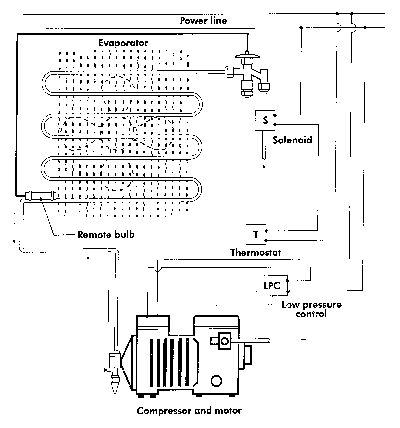The automatic pumpdown system consists of a normally closed liquid-line solenoid valve installed in the liquid line of a refrigeration system. The solenoid is a normally closed electric shut-off valve that is controlled by a thermostat. The thermostat is located somewhere in the refrigerated space.

The Pumpdown Cycle
When the desired box temperature is reached in the space, the thermostat will open and de-energize the liquid-line solenoid valve (Figure 1), closing the valve.The compressor will continue to run and will evacuate any refrigerant from the solenoid valve’s outlet, up to and including the compressor. This includes part of the liquid line, evaporator, suction line, and crankcase.
This refrigerant will be stored in the condenser and receiver on the high side of the refrigeration system. Most of the refrigerant will be stored in the receiver. (Automatic pumpdown systems do not need a larger receiver, since the receiver is designed to hold all of the refrigerant in the entire system and still have a 20% vapor head for safety.)
The compressor will be shut off by the action of a low-pressure switch set to open at about 5 to 10 psig. This will ensure that no refrigerant will migrate to the compressor during the off cycle.
The practice years ago was to pump the compressor down to 0 psig. This practice has proven to be hard on compressors because of reaching such low compression ratios at 0-psig suction pressure. Also, on refrigerant-cooled compressors, the compressor would be starved of refrigerant every time it pumped down and could suffer possible damage from overheating.
On a call for cooling, the thermostat will close and energize the liquid-line solenoid valve. This action will send liquid refrigerant to the expansion valve and into the empty evaporator, thus increasing the evaporator pressure.
Once the cut-in pressure of the low-pressure control is reached, the compressor will easily start and resume a normal refrigeration cycle.
The cut-in pressure of the low-pressure control should be set at a high enough pressure to ensure that the system will not short-cycle if residual pressure remains in the low side of the system once it’s pumped down.
Compressor short-cycling can be devastating to motor windings and starting controls because of overheating. However, the cut-in pressure has to be low enough to ensure that the system will cut in once the liquid-line solenoid is energized by the thermostat to start the next on cycle. These pressures are dependent on refrigerant type and the box temperature desired. Please consult the case manufacturer for specific cut-in pressure settings.
Automatic Pumpdown
Automatic pumpdown systems are not used on systems that have only small amounts of oil or refrigerant; there is not enough refrigerant to migrate to the oil and cause any damage if migration does occur.A good example of this would be a domestic refrigerator or freezer. Often these refrigerators/freezers will have a refrigerant charge of only 8 to 16 oz, and their oil charge will be from 12 to 20 oz. There is often more oil than refrigerant in these systems. Even if all of the refrigerant migrated to the crankcase during the off cycle, no real damage will be done since the refrigerant flashes off during the next on cycle.
If the refrigerant-to-oil ratio is large, automatic pumpdown systems should be employed. It’s a good practice to install automatic pumpdown systems on all refrigeration systems employing large amounts of refrigerant and oil.
Listed below are three main reasons an automatic pumpdown system would be used on a refrigeration system:
1. The pumpdown rids the evaporator, suction line, and crankcase of refrigerant before reaching the off cycle and defrost cycle, so migration of refrigerant to the compressor and/or crankcase cannot occur.
2. The pumpdown prevents surges of liquid refrigerant from entering the suction port of the compressor (slugging) during start-ups.
3. It rids the crankcase of refrigerant, preventing foaming of oil on start-ups, which robs the compressor’s mechanical parts of lubrication.
In next month’s column, we will look at types of automatic pumpdown control systems.
Tomczyk is a professor of hvac at Ferris State University, Big Rapids, MI, and author of Troubleshooting and Servicing Modern Air Conditioning & Refrigeration Systems, published by ESCO Press. To order, call 800-726-9696. Tomczyk can be reached at tomczykj@tucker-usa.com.
Sidebar: Rooftop Garden Designed To Save Energy
CHICAGO, IL — Reducing heating and air conditioning costs by putting a garden on the roof of an office building has become a reality here.
In late spring, officials showed off the garden atop the 12-story City Hall. Later this year, they hope to have a reading on how well the project did in curbing ac costs. By next spring, they want to get results on possible heating savings.
The project took close to a year to reach reality. The entire roof was covered with a lightweight planting mix rather than conventional planters due to weight considerations.
Nevertheless, the garden did weigh in at 350-tons, and assembly required the aid of a 7-ton crane. The custom mixture included humus and vermiculite. The garden has columbine and artemisia growing from the planting mix, which is covered with biodegradable green mesh and irrigated by drip hoses.
The use of plants, which eventually will include 150 varieties, is designed to help battle ozone pollution as well as curb energy costs.
The project is mainly in response to the ozone and energy issues. The site is not accessible to the public as the only way up is through the boiler room.
Publication date: 11/05/2001

Report Abusive Comment